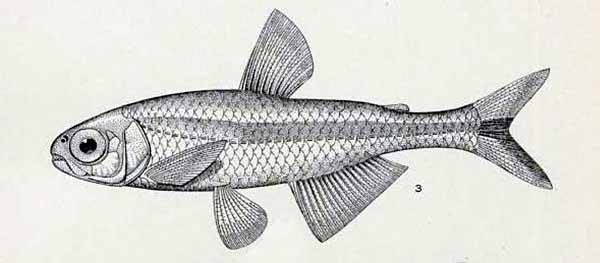Hemibrycon tridens
Eigenmann, 1922
|
Familie: Characidae Lokale Bezeichnung |
 Hemibrycon tridens (Fig 3, aus Pl 96 aus: Eigenmann, C.H. 1927. The American Characidae. Memoirs of the Museum of Comparative Zoology, 43 (4): 311-428, 24 pls.; (BHL) |
Typen
Holotypus: CAS 44358 [ex IU 13723] .
Siehe: Eschmeyer, W.N., Fricke, R. & Van der Laan, R. (eds.) 2024. Catalog of Fishes electronic version
Typusfundort: Río Apurimac bei Uruhuasi, südöstliches Peru.
Etymologie
Tri- (= drei); dens (= Zähne), bezieht sich auf die Trikuspidalzähne, die sich entlang des größeren Teils des Oberkiefers erstrecken. (Übersetzt aus: The ETYFish Project)
Verbreitung
Peru: Río Apurimac, oberer Río Ucayali Einzug, Curuhuasi.
IUCN Status

EX Extinct (ausgestorben)
EW Extinct in the Wild (in der Natur ausgestorben)
CR Critically Endangered (vom Aussterben bedroht)EN Endangered (stark gefährdet)
VU Vulnerable (gefährdet)
NT Near Threatened (potenziell gefährdet)
LC Least Concern (nicht gefährdet)
RE Regionally Extinct (regional oder national ausgestorben)DD Data Deficient (ungenügende Datengrundlage)
NE Not Evaluated (nicht beurteilt)
LC Least Concern (nicht gefährdet)
Gefahren für diese Art: (nicht beurteilt)
Literatur
- Eigenmann, C.H. 1922. The fishes of western South America, Part I. The fresh-water fishes of northwestern South America, including Colombia, Panama, and the Pacific slopes of Ecuador and Peru, together with an appendix upon the fishes of the Rio Meta in Colombia. Memoirs of the Carnegie Museum, 9 (1): 1–346, Pls. 1–38. Zitatseite [:152, !!]
- Eigenmann, C.H. 1927. The American Characidae. Memoirs of the Museum of Comparative Zoology, 43 (4): 311-428, 24 pls. (BHL) Zitatseite [:402, (im Artenschlüssel), 403-404 (pl. 96, fig. 3]
- Schultz, H. 1962. Fischfang in der Umgegend von Manaus, Brasilien. Tropische Fische, 2 (6): 278-286. Zitatseite [:285*, Farbfoto]
- Géry, J. 1962. Notes on the ichthyology of Surinam and other Guianas. 10. The distribution pattern of the genus Hemibrycon, with a description of a new species from Surinam and an incursion into ecotaxonomy. Bulletin of Aquatic Biology, 3 (28) [1962]: 65–80. Zitatseite [:66]
- Géry, J. 1977. Characoids of the World. T.F.H. Publications, Neptune City. 1-672. Zitatseite [:379, Vorkommen]
- Ortega, H. & Vari, R.P. 1986. Annotated checklist of the freshwater fishes of Peru. Smithsonian Contributions to Zoology, 437: iii + 25 p. Zitatseite [:8, gelistet]
- Bertaco, V.A. & Malabarba, L.R. 2010. A review of the Cis-Andean species of Hemibrycon Günther (Teleostei: Characiformes: Characidae: Stevardiinae), with description of two new species. Neotropical Ichthyology, 8 (4): 737-770. (doi) Zitatseite [:765, Figs. 25, Farbfoto: kons. Holotypus, Wiederbeschreibung, Verbreitung]
- Román-Valencia, C., Ruiz-C, R.I., Taphorn, D.C. & García-Alzate, C.A. 2014. A new species of Hemibrycon (Characiformes, Characidae) from the upper San Juan River drainage, Pacific versant, Colombia. ZooKeys, 454: 109-125. (doi) Zitatseite [:120]
- Thomaz, A.T., Arcila, D., Ortí, G. & Malabarba, L.R. 2015. Molecular phylogeny of the subfamily Stevardiinae Gill, 1858 (Characiformes: Characidae): classification and the evolution of reproductive traits. BMC Evolutionary Biology, 15: 146. (doi) Zitatseite [:Add. 5]
